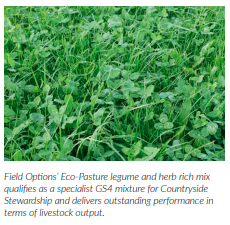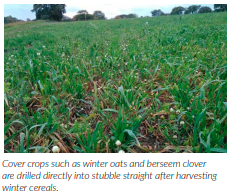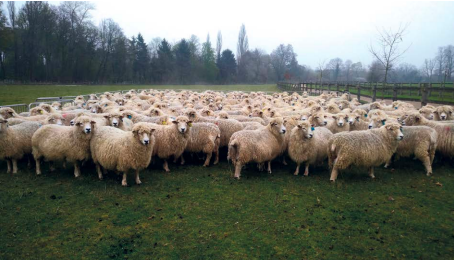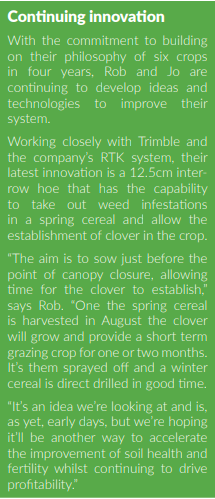The challenge for UK agriculture is to build a sustainable and profitable future under a changing support structure, and restoring soil health to vast acreages of farmland will be key.
That’s certainly the view of Rob and Jo Hodgkins, who as educated selfstarters in the farming industry have experienced first-hand the damage reeked over recent decades by modern large scale agricultural practices. Both Nuffield Scholars and graduates of the Worshipful Company of Farmers’ Advanced Business Management programme, the couple are committed to a farming methodology that has soil health at its core. Their approach includes the integration of livestock back onto arable farms, with cover crops included in a rotation that can see as many as six profit-generating crops grown in a four year period.

“We believe there is a sustainable business model that can work for a great number of arable farms, particularly where significant areas are compromised by poor soil health or by issues such as black-grass,” says Rob. “However, it requires a real change of mindset and a fully committed approach to be successful. “Through our own experiences, we’ve taken land with significant weed grass problems and poor soil structure – land that has been plundered for 20-25 years – and turned it around, making a decent return in the process.”
Rob and Jo started with just 60 acres and 200 cull ewes back in 2013 and have now built their Kaiapoi farming enterprise that currently includes 1,600 arable acres and 1,000 acres of grassland in north Hertfordshire, all on Farm Business Tenancy agreements, and 2,500 New Zealand Romney ewes. They have developed a system with a four year arable rotation, alternating winter and spring crops to help combat the inherent black-grass infestations. Cover crops are grown in between winter and spring crops, providing over-winter grazing for ewes and finishing lambs.
“We tend to follow a winter cereal with a cover crop mixture of 100kg/ha of winter oats and 5kg/ha of berseem clover, direct drilled into the stubble straight after the combine,” says Rob. “The earlier establishment makes all the difference and creates a forage crop that ewes and fattening lambs are turned onto from September.” Around 200ha of over-winter cover crop grazing is supplemented with an additional 80-90ha of stubble turnips grown on a neighbouring farm.
“We like the stubble turnips for what they provide in terms of winter fodder but we’re in an area that suffers badly with flea beetle so find them very difficult to grow,” adds Rob. “Our neighbour grows a lot of winter barley, which allows earlier drilling of the stubble turnips and this seems to make all the difference in terms of establishment.”
The combination of cover crops and sheep make a valuable contribution to soil health and fertility, adding an estimated 35-50kgN/ha of available nitrogen for the following crop, in addition to building soil organic matter. “We don’t aim to graze the cover crops to the ground as we prefer to leave some crop residue on the surface,” says Rob. “Overall, the cover crops offer great flexibility and create options “This year, for example, we’ve been able to establish winter wheat in January following the cover crop, effectively turning what would have been a spring crop into a winter crop. “That’s potentially going to be really beneficial this year looking at the value of winter cereals.”

Sheep genetics
Key to the success of the system, according to Rob, is having the right sheep genetics. He’s an advocate for the New Zealand Romney, a breed that he rates due to its low maintenance characteristics, resistance to foot rot and its ability to be lambed outdoors with minimal trouble, achieving 170- 180% lambing percentage. “Our system relies on a sheep breed that we can lamb outside, so we have little requirement for buildings, infrastructure and bought-in feed,” says Rob. “We also don’t need straw for bedding, and that’s good because we aim for around 90% of it to be chopped and spread to go back into the soil as organic matter.”

Rob describes his sheep as ‘Arable Romneys’, and that’s because they fit around the arable system, with lambing taking place in the early part of April when there’s a window of opportunity between routine arable operations. Also, with cover crops that cost as little as £30-£35/ha to grow providing ample winter feed, there’s no compulsion to sell lambs off the farm early, so instead the strategy is to make the most of what are typically better prices for finished lambs in January and February.
Quality grazing
Another key element of Rob and Jo’s system are five-year herbal leys, grown as legume and herb rich pastures as part of a Countryside Stewardship Scheme. Within their 1,600 acre enterprise, around 300- 400 acres will be down to herbal leys at any one time, these providing all the grazing from lambing time though to September when the sheep move onto the cover crops. Whilst there are some restrictions around what is grown and how the leys are managed, there are significant support payments – in excess of £300/ha – and additional grants available to fund infrastructure.
Specialist GS4 mixtures are supplied by Field Options and have been developed with maximum productivity as well as compliance as joint objectives. Testing is carried out at Field Options’ trials site at Harper Adams University, where the best performing mixture, Eco-Pasture, produced 1.3 tonnes of dry matter per hectare more than Field Options’ leading long term mixture. Put in terms of output potential, this equates to 1,300 extra grazing days or more than 300kg of additional liveweight per hectare.
“With the leys unstocked over the winter, we are lambing on covers of 1,700 – 2,000kgDM/ha, which allows us to keep the ewes and lambs tightly stocked and this minimises the risk of separation. I’m sure this helps to boost lamb survival rates and – with the quality of grazing available – they do well. “We split fields into four or five areas with electric fencing, to rotationally graze, which maximises utilisation whilst also allowing us to comply with the requirement for a five week environmental rest period.”
Adopting a model approach
With Rob and Jo’s combined expertise, the Kaiapoi enterprise is developing into a sustainable and profitable business. It’s an approach that they believe has merit in the wider arable farming industry and they have demonstrated this through a comprehensively costed model.

Taking a 1,400 – 1,600 acre arable unit as an example, they have shown how putting the least productive 300-400 acres into a Countryside Stewardship Scheme – and integrating cover crops into the remaining arable rotation – can create the platform for a 1,000 ewe enterprise. “We recognise the importance of expertise and have costed in a fulltime shepherd and also allowed for capital expenditure on vital equipment such as a handling system,” says Rob. “By taking advantage of Countryside Stewardship, and ensuring you have the right breed of sheep to complement the system, this can be a profitable way forward. “I think there are a lot of farms where the worst performing 15-20% of the arable acreage is generating minimal profit, due to issues such as poor soil health or weed grass infestations. Integrating livestock into the system in the way we’re outlining may well be the best way to go.”
